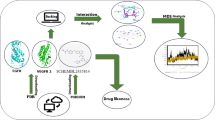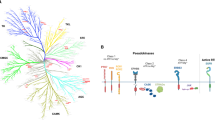Abstract
Despite the remarkable clinical activity of kinase inhibitors against anaplastic lymphoma kinase (ALK) and the closely related Ros1 and TRKA kinases, the emergence of resistance to these inhibitors often leads to relapse in most patients. Resistance is usually in the form of mutations and brain metastasis or inhibitors failing to penetrate the blood-brain barrier. The discovery of entrectinib has recently paved way for further exploration of kinase inhibitors that target ALK after it has reportedly demonstrated potency against ALK, Ros1, and TRKA kinases. However, the molecular mechanism surrounding its multi-targeting activity remains unresolved. As such, in this study, we investigate the pan-inhibitory mechanism of entrectinib towards ALK, Ros1, and TRKA, using in silico techniques. Findings show strong binding affinities of ALK = −40.92 kcal/mol, Ros1 = −36.60 kcal/mol, and TRKA = −45.99 kcal/mol for entrectinib towards ALK, Ros1, and TRKA, respectively. Pan-inhibitory binding of entrectinib is characterized by close interaction with peculiar gatekeeper residues on each tyrosine kinase. Entrectinib induced structural stability and rigidity in the backbone conformation of all three tyrosine kinases by showing a consistent pattern of structural alterations. These structural insights provided presents a baseline for the understanding of the pan-inhibitory activity of entrectinib. Establishing the cruciality of the interactions between the phenyl ring and gatekeeper residues could guide the structure-based design of novel tyrosine kinase inhibitors with improved therapeutic activities.





Similar content being viewed by others
References
Siveen, K.S., et al. (2018) Role of non receptor tyrosine kinases in hematological malignances and its targeting by natural products. Molecular Cancer, 17(1). https://doi.org/10.1186/s12943-018-0788-y.
Lemmon, M.A., & Schlessinger, J. (2010) Cell signaling by receptor tyrosine kinases. Cell, 141(7). https://doi.org/10.1016/j.cell.2010.06.011.
Bhullar, K.S., et al. (2018) Kinase-targeted cancer therapies: progress, challenges and future directions. Molecular Cancer, 17(1). https://doi.org/10.1186/s12943-018-0804-2.
Berg, L.J., Finkelstein, L.D., Lucas, J.A., & Schwartzberg P.L. (2005) Tec family kinases in t lymphocyte development and function. Annual Review of Immunology, 23(1). https://doi.org/10.1146/annurev.immunol.22.012703.104743.
Metibemu, D.S., Akinloye, O.A., Akamo, A.J., Ojo, D.A., Okeowo, O.T., & I.O. (2019) Omotuyi exploring receptor tyrosine kinases-inhibitors in Cancer treatments. Egyptian Journal of Medical Human Genetics, 20(1). https://doi.org/10.1186/s43042-019-0035-0.
Menichincheri, M., et al. (2016) Discovery of Entrectinib: a New 3-Aminoindazole as a potent anaplastic lymphoma kinase (ALK), c-ros Oncogene 1 Kinase (ROS1), and pan-tropomyosin receptor kinases (Pan-TRKs) inhibitor. Journal of Medicinal Chemistry, 59(7). https://doi.org/10.1021/acs.jmedchem.6b00064.
Shaw, A.T., & Engelman, J.A. (2013) ALK in lung cancer: Past, present, and future. Journal of Clinical Oncology, 31(8). https://doi.org/10.1200/JCO.2012.44.5353.
Klempner, S.J., Myers, A.P., Mills, G.B., & Westin, S.N. (2013) Clinical investigation of receptor and non-receptor tyrosine kinase inhibitors for the treatment of epithelial ovarian cancer. Expert Opinion on Pharmacotherapy, 14(16). https://doi.org/10.1517/14656566.2013.826650.
Hartmann, J.T., Haap, M., Kopp, H.-G., & Lipp, H.-P. (2009) Tyrosine kinase inhibitors – a review on pharmacology, metabolism and side effects. Current Drug Metabolism, 10(5). https://doi.org/10.2174/138920009788897975.
Negi, A., Ramarao, P., & Kumar, R. (2013) Recent advancements in small molecule inhibitors of insulin–like growth factor-1 receptor (IGF-1R) tyrosine kinase as anticancer agents. Mini-Reviews in Medicinal Chemistry, 13(5). https://doi.org/10.2174/1389557511313050004.
Zblewski, D., et al. (2018) The clinical utility of pharmacogenomics testing in assessing tyrosine kinase inhibitor therapy, intolerance and responses in patients with chronic myelogenous leukemia. Blood, 132(Supplement 1). https://doi.org/10.1182/blood-2018-99-118600.
Drilon, A., et al. (2017) Safety and antitumor activity of the multitargeted pan-TRK, ROS1, and ALK inhibitor entrectinib: combined results from two phase I trials (ALKA-372-001 and STARTRK-1). Cancer Discovery, 7(4). https://doi.org/10.1158/2159-8290.CD-16-1237.
Pettersen, E. F., et al. (2004). UCSF Chimera - a visualization system for exploratory research and analysis. Journal of Computational Chemistry, 25(13), 1605–1612. https://doi.org/10.1002/jcc.20084.
Awad, M.M., et al. (2013) Acquired resistance to crizotinib from a mutation in CD74 – ROS1. The New England Journal of Medicine, 368(25). https://doi.org/10.1056/nejmoa1215530.
Subramanian, G., et al. (2019) Deciphering the allosteric binding mechanism of the human tropomyosin receptor kinase A (hTrkA) inhibitors. ACS Chemical Biology, 14(6). https://doi.org/10.1021/acschembio.9b00126.
Kusumaningrum, S., Budianto, E., Kosela, S., Sumaryono, W., & Juniarti, F. (2014). The molecular docking of 1,4-naphthoquinone derivatives as inhibitors of Polo-like kinase 1 using Molegro Virtual Docker. Journal of Applied Pharmaceutical Science, 4(11), 47–53. https://doi.org/10.7324/JAPS.2014.4119.
Hanwell, M.D., Curtis, D.E., Lonie, D.C., Vandermeerschd, T., Zurek, E., & Hutchison, G.R. (2012) Avogadro: an advanced semantic chemical editor, visualization, and analysis platform. Journal of Cheminformatics, 4(8). https://doi.org/10.1186/1758-2946-4-17.
Salomon-Ferrer, R., Case, D.A., & Walker, R.C. (2013) An overview of the Amber biomolecular simulation package. Wiley Interdisciplinary Reviews: Computational Molecular Science, https://doi.org/10.1002/wcms.1121.
Berendsen, H. J. C., Postma, J. P. M., van Gunsteren, W. F., DiNola, A. & Haak, J. R. (1984). Molecular dynamics with coupling to an external bath. The Journal of Chemical Physics, 81, 3684–3690. https://doi.org/10.1063/1.448118.
Kräutler, V., Van, W. F., Gunsteren, & Hünenberger, P. H. (2001). A fast SHAKE algorithm to solve distance constraint equations for small molecules in molecular dynamics simulations. Journal of Computational Chemistry, 22(5), 501–508. 10.1002/1096-987X(20010415)22:5<501::AID-JCC1021>3.0.CO;2-V.
Daniel R Roe, Thomas E Cheatham 3rd (2013) PTRAJ and CPPTRAJ: software for processing and analysis of molecular dynamics trajectory data.Journal of chemical theory and computation 9(7):3084-95. https://doi.org/10.1021/ct400341p.
Dassault Systems Biovia Discovery Studio 2016 Client. San Diego Dassault Systèmes, 2016.
Seifert, E. (2014) OriginPro 9.1: scientific data analysis and graphing software-software review. Journal of Chemical Information and Modeling, 54(5), 1552 https://doi.org/10.1021/ci500161d.
Massova, I., & Kollman, P.A. (2000) Combined molecular mechanical and continuum solvent approach (MM-PBSA/GBSA) to predict ligand binding. no. i, pp. 113–135.
Kollman, P. A., Massova, I., Reyes, C., Kuhn, B., Huo, S., Chong, L., … Cheatham, T. E. (2000). Calculating Structures and Free Energies of Complex Molecules: Combining Molecular Mechanics and Continuum Models. Accounts of Chemical Research, 33(12), 889–897. https://doi.org/10.1021/ar000033j.
Miller, B.R., Mcgee, T.D., Swails, J.M., Homeyer, N., Gohlke, H., & Roitberg, A.E. (2012) MMPBSA. py: an efficient program for end-state free energy calculations. https://doi.org/10.1021/ct300418h.
Onufriev, A., Bashford, D., & Case, D. A. (2000). Modification of the Generalized Born Model Suitable for Macromolecules. The Journal of Physical Chemistry B, 104(15), 3712–3720. https://doi.org/10.1021/jp994072s.
Doree Sitkoff, Kim A. Sharp, and Barry Honig (1994) Accurate calculation of hydration free energies using macroscopic solvent models. Journal of Physical chemistry pp. 1978–1988. https://doi.org/10.1021/j100058a043.
Iwahara, T., et al. (1997) Molecular characterization of ALK, a receptor tyrosine kinase expressed specifically in the nervous system. Oncogene, 14(4). https://doi.org/10.1038/sj.onc.1200849.
Morris, S.W., et al. (1997) ALK the chromosome 2 gene locus altered by the t(2;5) in non-Hodgkin’s lymphoma, encodes a novel neural receptor tyrosine kinase that is highly related to leukocyte tyrosine kinase (LTK). Oncogene, 14(18). https://doi.org/10.1038/sj.onc.1201062.
Mossé, Y.P., et al. (2008) Identification of ALK as a major familial neuroblastoma predisposition gene. Nature, 455(7215). https://doi.org/10.1038/nature07261.
Stoica, G.E., et al. (2001) Identification of anaplastic lymphoma kinase as a receptor for the growth factor pleiotrophin. Journal of Biological Chemistry, 276(20). https://doi.org/10.1074/jbc.M010660200.
Vaishnavi, A., Le, A.T., & Doebele, R.C. (2015) TRKing down an old oncogene in a new era of targeted therapy. Cancer Discovery, 5(1). https://doi.org/10.1158/2159-8290.CD-14-0765.
T. Wang, D. Yu, and M.L. Lamb Trk kinase inhibitors as new treatments for cancer and pain. Expert Opinion on Therapeutic Patents, 19, 3. 2009, https://doi.org/10.1517/13543770902721261.
Schneider, R., & Schweiger, M. (1991) A novel modular mosaic of cell adhesion motifs in the extracellular domains of the neurogenic trk and trkB tyrosine kinase receptors. Oncogene, 6(10).
Klein, R., Jing, S., Nanduri, V., O’Rourke E., & Barbacid M. (1991) The trk proto-oncogene encodes a receptor for nerve growth factor. Cell, 65(1). https://doi.org/10.1016/0092-8674(91)90419-Y.
Kaplan, D.R., Martin-Zanca, D., & Parada, L.F. (1991) Tyrosine phosphorylation and tyrosine kinase activity of the trk proto-oncogene product induced by NGF. Nature, 350(6314). https://doi.org/10.1038/350158a0.
Shen, J., & Maruyama, I.N. (2011) Nerve growth factor receptor TrkA exists as a preformed, yet inactive, dimer in living cells. FEBS Letters, 585(2). https://doi.org/10.1016/j.febslet.2010.12.031.
Drilon, A., et al. (2019) Abstract 442: Repotrectinib, a next generation TRK inhibitor, overcomes TRK resistance mutations including solvent front, gatekeeper and compound mutations. https://doi.org/10.1158/1538-7445.sabcs18-442.
Abdullahi, M., Olotu, F. A., & Soliman, M. E. (2018). Allosteric inhibition abrogates dysregulated LFA-1 activation: structural insight into mechanisms of diminished immunologic disease. Computational Biology and Chemistry, 73, 49–56. https://doi.org/10.1016/j.compbiolchem.2018.02.002.
Author information
Authors and Affiliations
Corresponding author
Ethics declarations
Conflict of Interest
The authors declare no competing interests.
Additional information
Publisher’s note Springer Nature remains neutral with regard to jurisdictional claims in published maps and institutional affiliations.
Rights and permissions
About this article
Cite this article
Salifu, E.Y., Issahaku, A.R., Agoni, C. et al. Prioritizing the Catalytic Gatekeepers through Pan- Inhibitory Mechanism of Entrectinib against ALK, ROS1 and TRKA Tyrosine Kinases. Cell Biochem Biophys 80, 11–21 (2022). https://doi.org/10.1007/s12013-021-01052-2
Received:
Accepted:
Published:
Issue Date:
DOI: https://doi.org/10.1007/s12013-021-01052-2




